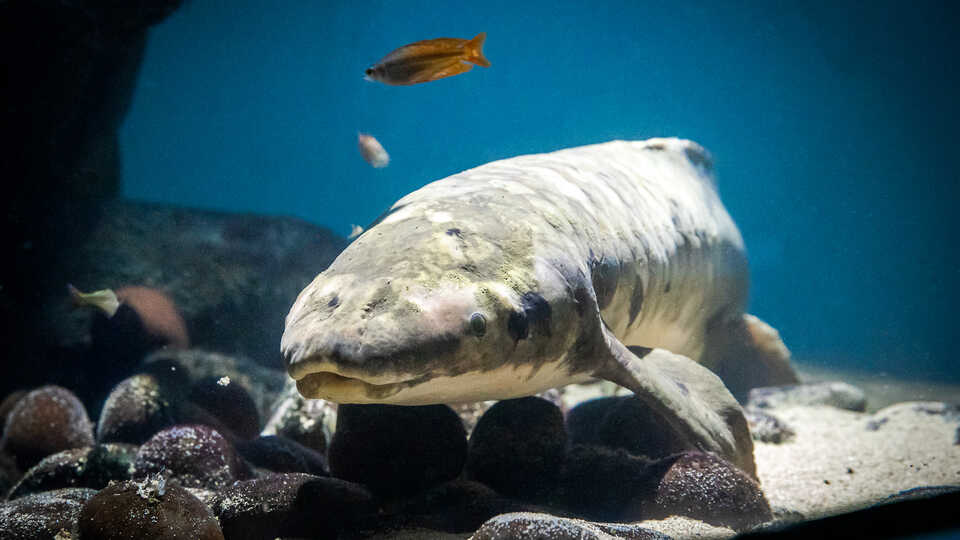Methuselah the nonagenarian Australian lungfish’s age comes just in time for Steinhart Aquarium’s centennial

Gayle Laird © California Academy of Sciences
SAN FRANCISCO, CA (September 18, 2023)— The California Academy of Sciences is excited to reveal the age of beloved Australian lungfish Methuselah (Neoceratodus forsteri), the oldest living fish in an aquarium anywhere in the world. Cutting-edge DNA analysis led by Dr. Ben Mayne of CSIRO and Dr. David T. Roberts of Seqwater estimated Methuselah’s age to be 93 (± 9 years), older than her previously estimated age of 84.
Methuselah has been a Steinhart Aquarium staple since she first arrived via a Matson Navigation Company liner in November 1938, and has far outlived the 231 other fishes from Fiji and Australia that arrived with her. She has become famous not only for her advanced age, but for her charming personality and penchant for belly rubs. The information about Methuselah’s age comes just ahead of Steinhart Aquarium’s 100th anniversary on September 29. With an age estimate upper limit of 102, Methuselah could also be celebrating her centennial this year along with Steinhart Aquarium.
While this is an exciting development for Steinhart Aquarium and Methuselah, information about the fish’s age is even more poignant as part of a larger study to help accurately age lungfish in the wild and inform conservation efforts.
“Although we know Methuselah came to us in the late 1930s, there was no method for determining her age at that time, so it’s incredibly exciting to get science-based information on her actual age,” says Charles Delbeek, Curator of Aquarium Projects at Steinhart Aquarium. “Methuselah is an important ambassador for her species, helping to educate and stoke curiosity in visitors from all over the world. But her impact goes beyond delighting guests at the aquarium: Making our living collection available to researchers across the world helps further our understanding of biodiversity and what species need to survive and thrive.”
Methuselah and the Academy’s two other lungfish (ages 55 and 51) were included in a study led by Drs. Mayne and Roberts, which sampled 30 other lungfish from 6 other institutions across the USA and Australia to create a catalog of living lungfish that will advance the accuracy of the previously developed DNA-based age clock for the species. Estimating ages for such long lived and ancient fish is notoriously difficult and technically challenging, and has traditionally relied on more invasive and sometimes lethal aging methods such as examining otoliths, or earbones, and whole scale removal. Their new method uses a tiny tissue sample from a fin clip less than 0.5 cm2, a harmless methodology that can be applied to threatened species without impacting populations or the animal’s health.
“For the first time since the Australian lungfish’s discovery in 1870, the DNA age clock we developed offers the ability to predict the maximum age of the species,” Dr. Mayne said. “Accurately knowing the ages of fish in a population, including the maximum age, is vital for their management. This tells us just how long a species can survive and reproduce in the wild, which is critical for modeling population viability and reproductive potential for a species. It is a rare and valuable opportunity for researchers to access exceptionally long lived fish such as Methuselah kept in the care of California Academy of Sciences, as it helps us understand maximum longevity of a species under ideal care conditions,” he said.
Dr. Roberts adds, “By aging living lungfish from across the world we are creating a library of living lungfish that will enable Dr. Mayne and other researchers working on longevity of the vulnerable Australian Lungfish, to continually recalibrate the aging clock as new and older aged samples of lungfish become available. Methuselah’s age was challenging to calculate as her age is beyond the currently calibrated clock. This means her actual age could conceivably be over 100, placing her in the rare club of fish centenarians. While her age prediction will improve over time, she will always live beyond the calibrated age clock, as no other lungfish we know is older than Methuselah.
“This research highlights the important and often serendipitous discoveries that can occur from working with public aquariums and institutions that maintain protected species in their care. This approach to researching longevity of rare and endangered animals could be extrapolated to almost any vertebrate species, and demonstrates the value that animal care institutions such as the California Academy of Sciences can play in advancing animal knowledge to improve conservation management of species in the wild,” says Dr. Roberts.
Drs. Mayne and Roberts plan to publish the full study findings in later this year. Their original method development paper published in June 2021 in Molecular Ecology Resources provides a detailed description of how threatened fish can be safely aged with DNA methylation methods.
ASSETS:
- Photos of Methuselah, credit Gayle Laird, California Academy of Sciences.
- Video: Meet Methuselah, Celebrating a Longtime Academy Icon
- Video: Newly Discovered in the Archives: A Methuselah Mystery (April Fool’s Day)
Press Contacts
If you are a journalist and would like to receive Academy press releases please contact press@calacademy.org.
Digital Assets
Hi-res and low-res image downloads are available for editorial use. Contact us at press@calacademy.org to request access.